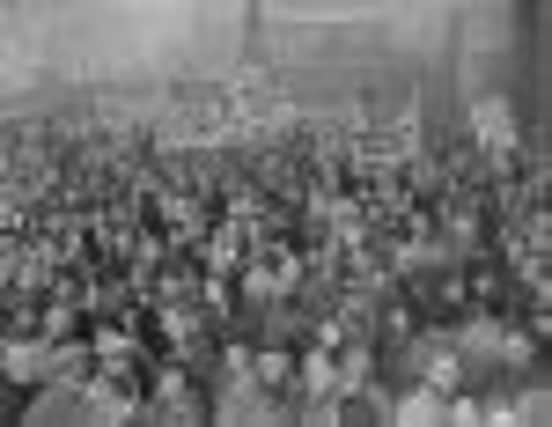Book review - Fascist Scotland: Caledonia And The Far Right by Gavin Bowd


Fascist Scotland: Caledonia And The Far Right
Gavin Bowd
Birlinn, £12.99
It’s not an option open to the historian, but that doesn’t mean the chronicler must eschew an occasional beguiling “what if”, or a well-placed “if only”, or a thankful “there but for the grace…”
It is a tendency to be found in the title, in the text and between the lines of Gavin Bowd’s Fascist Scotland. Indeed, this suggestiveness boasts a certain piquancy, given that so many of the unrealised possibilities which are evoked here address issues which have a contemporary currency in Scotland today. No matter how one might resist reading this book through the prism of the present, it consistently demands that we reflect on the darkest readings of nationhood, identity and the nature of leadership, and balance competing claims for the future on the discerning scales of history.
Advertisement
Hide AdSix chapters address British fascism and its interface with Scottish sectarianism, the fasci of the Italian community, pro-Franco sympathisers, Nazism and Scottish nationalism, Scottish Nazi activists and spies, and post-1945 manifestations of the far right in Scotland. For the most part, however, this is a book that concentrates (and is strongest) on the period 1918-1945.
The range of themes covered by Bowd gives the book a commendable reach, but this also explains its episodic quality: as the focus of each chapter shifts, the potential to highlight connections (and points of difference) between the various groups is compromised somewhat. Instead, we are left with the impression of discrete stories which need to be set more firmly in the context of the politics of the times in which they were (as Bowd reminds us) largely a fringe interest.
That said, Bowd’s approach allows us to see Scottish fascism in all its local colour and diversity. This is a thorough and well-researched social, political and cultural study that is truly national in scope. A central paradox that Bowd’s fluid prose ably brings to light is the way in which a global political phenomenon found its expression, for the most part, in small-town Scotland – in the politics of places that more familiar histories leave out, and among political classes seldom mentioned in the same breath.
So, instead of the “stair heid” revolutionaries of the Red Clyde, we have the female kitchen campaigners of the British Fascisti. Dumfries and Dalbeattie are shown to have supported some of the strongest fascist groups, and Alness produced one of its prophets.
But what about those “might have beens”? Scotland’s position in the Union state, and the malleability of Scottish and British identities refracted fascist notions of nationhood in ways that undermined its message. Patriotism, race, ethnicity and the call of empire could not be easily accommodated in a unitary vision of a fascist British (or Scottish) state without something (or someone) being lost to the cause.
That said, the strong associational dynamic of Scottish fascism highlights how organisational forms familiar to civic Scotland could sustain a divisive creed and render a vision of “authentic” Scottishness exclusive to a narrow minority.
Advertisement
Hide AdTrue, racial notions of identity were common, but they did not necessarily all point in the one direction. Indeed, the failure of the literary Renaissance to effect a popular cultural revolution showed that there was little in the language or traditions of modern Scotland which could deliver the essentialism which fascism required. Were we Celts, or Picts, or Anglo-Saxons? Was our tongue Gaelic or Scots, or had we need of Lallans?
There was a reason why MacDiarmid looked elsewhere when poetry failed to rhyme the people into revolt. And yet the loyalty to “home” of the Italian fasci was a prescient reminder that Scotland was a migrant nation – a meeting point of several diaspora peoples. It’s not surprising that, as Bowd shows, Scottish fascist interests regularly ran aground on the rocks of competing English, Irish, and continental European claims, or were spoilt for choice when it came to people to scapegoat: Jews, Roman Catholics, the English.
Advertisement
Hide AdAll this might have been less problematic had Scottish fascism boasted a leader worthy of a cult. It didn’t. Bowd’s fascist protagonists often have a faintly comic air (take Professor Sarolea’s bibliophilia) or an unattractive arrogance (Archibald Maule Ramsay MP) or cowardly tendencies (Raven Thomson’s constant complaints from prison). None commanded unconditional support. Even in February 1945, Alexander Ratcliffe, leader of the Scottish Protestant League, would declare that “Britain’s only hope lies in Hitler”.
Nationhood, identity, the nature of leadership: it’s not surprising that both Scottish fascism and Scottish nationalism debated the same questions in the interwar years and at times came dangerously close to the same conclusions. Both identified in the “foul air of our contemporary chaos” (MacDiarmid) a need for a radical solution. The ultimate outcome, born of war and the sacrifice of millions, means that we still are at liberty to examine these questions.
• Catriona MM Macdonald is Reader in Late Modern Scottish History at the University of Glasgow and co-editor of the Scottish Historical Review